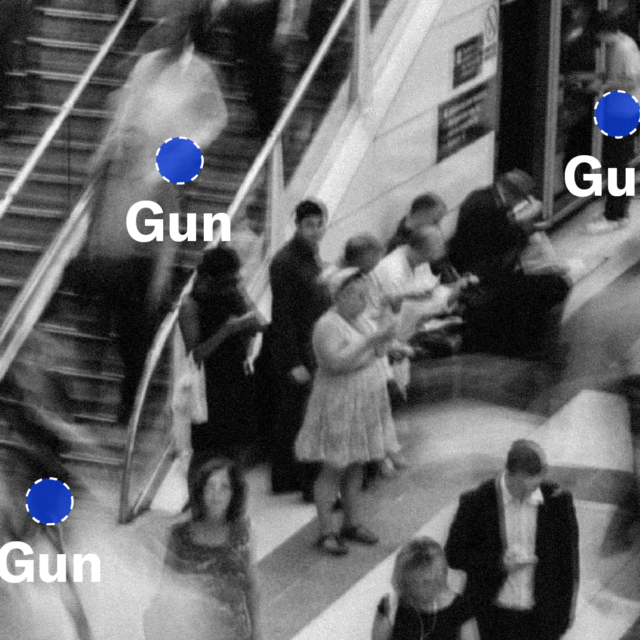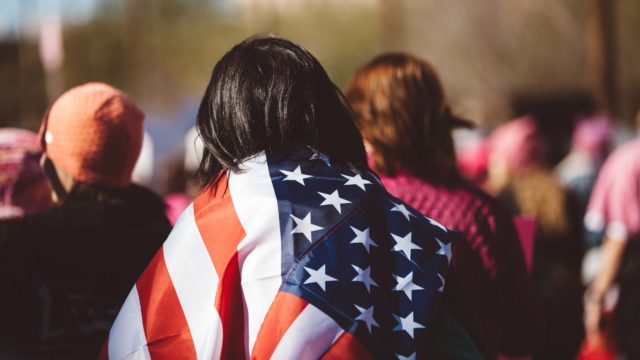
Every day, 125 people in the US are killed with guns and more than 200 are shot and wounded.1Everytown Research analysis of Centers for Disease Control and Prevention, National Center for Health Statistics. WONDER Online Database, Provisional Mortality Statistics, Multiple Cause of Death (accessed September 1, 2024), 2019–2023, and Healthcare Cost and Utilization Project (HCUP) nonfatal firearm injury data, 2020. Everytown For Gun Safety Support Fund, “EveryStat: United States,” https://everystat.org/. The effects of gun violence in America extend far beyond these casualties—gun violence shapes the lives of millions who witness it, know someone who was shot, or live in fear of the next shooting.
In order to illustrate the magnitude of everyday gun violence Everytown has gathered the most comprehensive, publicly available data. Still, significant data gaps remain—a result of underfunded, incomplete data collection at the state and federal levels. Filling these gaps is necessary to truly understand the full impact of gun violence in America.
Gun Deaths by Intent
Average number of people killed with guns in the United States each year: 45,7382Everytown Research of Centers for Disease Control and Prevention, National Center for Health Statistics, WONDER Online Database, Provisional Mortality Statistics, Multiple Cause of Death (accessed September 1, 2024). Average: 2019 to 2023. While it is broadly considered to be the most comprehensive firearm fatal injury source, two of the intent categories—legal intervention (e.g., shootings by police) and unintentional deaths—are estimated to be greatly underreported. This underreporting is largely due to missing information on death certificates, which may result in misclassification of intent. Multiple media sources and nonprofit groups have tracked shootings by police, but no reliable public database captures unintentional shootings. Intent category averages may not total to yearly average due to rounding.
Gun Deaths by Intent
Last updated: 11.7.2024
Gun Suicide
3x
Access to a gun triples the risk of death by suicide.
- When it comes to gun violence in the US, nearly 6 out of every 10 gun deaths are suicides.3Everytown Research analysis of Centers for Disease Control and Prevention, National Center for Health Statistics. WONDER Online Database, Provisional Mortality Statistics, Multiple Cause of Death (accessed September 1, 2024). Average: 2019 to 2023.
- The US gun suicide rate is nearly 12 times that of other high-income countries.4Everytown Research analysis of the most recent year of gun suicides by country (2015 to 2019), GunPolicy.org (accessed January 7, 2022).
- Access to a gun triples the risk of death by suicide.5Andrew Anglemyer, Tara Horvath, and George Rutherford, “The Accessibility of Firearms and Risk for Suicide and Homicide Victimization Among Household Members,” Annals of Internal Medicine 160, no. 2 (January 21, 2014): 101–10, https://doi.org/10.7326/M13-1301. Gun suicides are concentrated in states with high rates of gun ownership.6April Opoliner et al., “Explaining Geographic Patterns of Suicide in the US: The Role of Firearms and Antidepressants,” Injury Epidemiology 1, no. 6 (2014), https://doi.org/10.1186/2197-1714-1-6.
- White men represent 70 percent of firearm suicide victims in America.7Everytown Research analysis of Centers for Disease Control and Prevention, National Center for Health Statistics. WONDER Online Database, Provisional Mortality Statistics, Multiple Cause of Death (accessed September 1, 2024). Average: 2019 to 2023. White men defined as non-Latinx origin and all ages.
Gun Homicide
- More than four out of every 10 gun deaths are homicides.8Everytown Research analysis of Centers for Disease Control and Prevention, National Center for Health Statistics. WONDER Online Database, Provisional Mortality Statistics, Multiple Cause of Death (accessed September 1, 2024). Average: 2019 to 2023. Homicide includes shootings by police.
- The rate of gun violence in America is staggering: The US gun homicide rate is 26 times that of other high-income countries.9Everytown Research analysis of the most recent year of gun suicides by country (2015 to 2019), GunPolicy.org (accessed January 7, 2022).
- Access to a gun doubles the risk of death by homicide.10Andrew Anglemyer, Tara Horvath, and George Rutherford, “The Accessibility of Firearms and Risk for Suicide and Homicide Victimization Among Household Members,” Annals of Internal Medicine 160, no. 2 (January 21, 2014): 101–10, https://doi.org/10.7326/M13-1301.
- Gun homicides are concentrated in cities. An Everytown Research analysis of FBI crime data from nearly 600 cities11Sample limited to cities with populations of at least 65,000 that reported data to the FBI from 2019 to 2023. Everytown for Gun Safety Support Fund, “City Dashboard: Gun Homicide,” October 29, 2024, https://everytownresearch.org/report/city-data/. found that in 2023, over half of the gun homicides reported to the FBI occurred in just 42 cities, including Chicago, Philadelphia, Memphis, Houston, and others.12Everytown for Gun Safety Support Fund, “City Dashboard: Gun Homicide,” October 29, 2024, https://everytownresearch.org/report/city-data/. The complete list of 42 cities that comprise over 50% of gun homicides in this sample is: Chicago, IL; Philadelphia, PA; Memphis, TN; Houston, TX; Los Angeles, CA; Washington, DC; Dallas, TX; Detroit, MI; Baltimore, MD; New York, NY; Phoenix, AZ; Kansas City, MO; Milwaukee, WI; Indianapolis, IN; St. Louis, MO; San Antonio, TX; Louisville, KY; Cleveland, OH; Atlanta, GA; Oakland, CA; Birmingham, AL; Nashville, TN; Las Vegas, NV; Albuquerque, NM; Charlotte-Mecklenburg, NC; Fort Worth, TX; Columbus, OH; Denver, CO; Greensboro, NC; Minneapolis, MN; Cincinnati, OH; Portland, OR; Richmond, VA; Austin, TX; Little Rock, AR; Oklahoma City, OK; Seattle, WA; Baton Rouge, LA; Gary, IN; Newark, NJ; Stockton, CA; and Rochester, NY. Research shows that within these cities, a small percentage of the total population are people within the social networks most likely to be involved in gun violence. The majority of these people live in neighborhoods that are characterized by high rates of poverty, racial segregation and discrimination, and many other deep-rooted systemic and structural inequities.13David Weisburd, “The Law of Crime Concentration and the Criminology of Place,” Criminology 53, no. 2 (2015): 133–57, https://doi.org/10.1111/1745-9125.12070; Daniel C. Semenza et al., “Firearm Availability, Homicide, and the Context of Structural Disadvantage,” Homicide Studies (September 2021): 1–21, https://doi.org/10.1177/10887679211043806; Ben Green et al., “Modeling Contagion through Social Networks to Explain and Predict Gunshot Violence in Chicago, 2006 to 2014,” JAMA Internal Medicine 177, no. 3 (2017): 326–33, http://dx.doi.org/10.1001/jamainternmed.2016.8245; Chaeyoung Cheon et al., “Neighborhood Racial Composition and Gun Homicides,” JAMA Network Open 3, no. 11 (November 30, 2020): e2027591, https://doi.org/10.1001/jamanetworkopen.2020.27591; Mudia Uzzi et al., “An Intersectional Analysis of Historical and Contemporary Structural Racism on Non-Fatal Shootings in Baltimore, Maryland,” Injury Prevention 29, no. 1 (2023): 85-90, https://doi.org/10.1136/ip-2022-044700; Aliza Aufrichtig et al., “Want to Fix Gun Violence in America? Go Local,” The Guardian, January 9, 2017, https://bit.ly/2i6kaKw.
- Black Americans represent the majority of gun homicide victims. In fact, Black people in the US are more than 12 times more likely than white people to die by gun homicide.14Everytown Research analysis of Centers for Disease Control and Prevention, National Center for Health Statistics. WONDER Online Database, Provisional Mortality Statistics, Multiple Cause of Death (accessed September 1, 2024). Average: 2019 to 2023. Rates are age-adjusted. Black and white defined as non-Latinx origin. Homicide includes shootings by police.
The US gun homicide rate is 26 times that of other high-income countries.
Last updated: 11.1.2022
Children and Teens
- Firearms are the leading cause of death for American children and teens.15Everytown Research analysis of Centers for Disease Control and Prevention, National Center for Health Statistics, WONDER Online Database, Provisional Mortality Statistics, Multiple Cause of Death, Injury Mechanism & All Other Leading Causes, (accessed September 1, 2024). Data from 2023. Ages: 1–19. Age 0 to 1 excluded because leading causes of death for newborns and infants are specific to the age group.
- More than 2,800 children and teens die by gun homicide every year.16Everytown Research analysis of Centers for Disease Control and Prevention, National Center for Health Statistics, WONDER Online Database, Provisional Mortality Statistics, Multiple Cause of Death (accessed September 1, 2024). Average: 2019 to 2023. Ages: 0–19. Homicide includes shootings by police. For children under the age of 13, these gun homicides most frequently occur in the home and are often connected to domestic or family violence.17Katherine A. Fowler et al., “Childhood Firearm Injuries in the United States,” Pediatrics 140, no. 1 (2017), https://doi.org/10.1542/peds.2016-3486.
- Black children and teens in the US are more than 18 times more likely than white children and teens of the same age to die by gun homicide.18Everytown Research analysis of Centers for Disease Control and Prevention, National Center for Health Statistics. WONDER Online Database, Provisional Mortality Statistics, Multiple Cause of Death (accessed September 1, 2024). Average: 2019 to 2023. Ages: 0–19. Black and white defined as non-Latinx origin. Homicide includes shootings by police.
Firearms are the leading cause of death for children and teens in the US.
Last updated: 11.7.2024
Domestic Violence
6M
Nearly 6 million women reported having a gun used on them by an intimate partner.
Ruth W. Leemis et al., “The National Intimate Partner and Sexual Violence Survey: 2016/2017 Report on Intimate Partner Violence,” Centers for Disease Control and Prevention, October 2022, https://stacks.cdc.gov/view/cdc/124646. 4.7 percent of women (5.9 million) in the U.S. reported having a gun used on them by a current or former intimate partner at some point in their lifetime. While the survey question is up for interpretation by respondents and doesn’t provide further breakdowns, this count likely includes cases of being shot or shot at, hit with, and threats with a firearm.
- Women in the US are 28 times more likely to be killed with a gun than women in other high-income countries.19Everytown Research analysis of the most recent year of gun deaths by country (2015 to 2019), GunPolicy.org (accessed January 7, 2022).
- Every month, more than 70 women in the US are shot and killed by an intimate partner,20Everytown Research analysis of CDC, National Violent Death Reporting System (NVDRS), Average: 2020–2022. Analysis includes firearm homicides involving an intimate partner and women ages 18–85+. and many more are shot and wounded.
- Nearly 6 million women reported having a gun used on them21While the survey question is up for interpretation by respondents and doesn’t provide further breakdowns, this count likely includes cases of being shot or shot at, hit with, and threats with a firearm. by an intimate partner.224.7 percent of women (5.9 million) in the United States reported having a gun used on them by a current or former intimate partner at some point in their lifetime. Ruth W. Leemis et al., “The National Intimate Partner and Sexual Violence Survey: 2016/2017 Report on Intimate Partner Violence,” Centers for Disease Control and Prevention, October 2022, https://stacks.cdc.gov/view/cdc/124646.
- Access to a gun in a domestic violence situation makes it five times more likely that a woman will be killed.23Jacquelyn C. Campbell et al., “Risk Factors for Femicide in Abusive Relationships: Results From a Multisite Case Control Study,” American Journal of Public Health 93, no. 7 (July 2003): 1089–97, https://doi.org/10.2105/AJPH.93.7.1089.
Impact on Americans
- 59 percent of adults or someone they know or care about have experienced gun violence in their lifetime.24Everytown for Gun Safety Support Fund, “Gun Violence Survivors in America,” February 1, 2023, https://everytownresearch.org/report/gun-violence-survivors-america/.
- Approximately 3 million American children witness gun violence every year.25David Finkelhor et al., “Prevalence of Childhood Exposure to Violence, Crime, and Abuse: Results From the National Survey of Children’s Exposure to Violence,” JAMA Pediatrics 169, no. 8 (August 1, 2015): 746–54, https://doi.org/10.1001/jamapediatrics.2015.0676. Everytown analysis derives the 3 million number by multiplying the share of children (ages 0-17) who are exposed to shootings per year (4.2%) by the total child population of the U.S. in 2016 (~73.5M).
MORE RESEARCH
Share these statistics
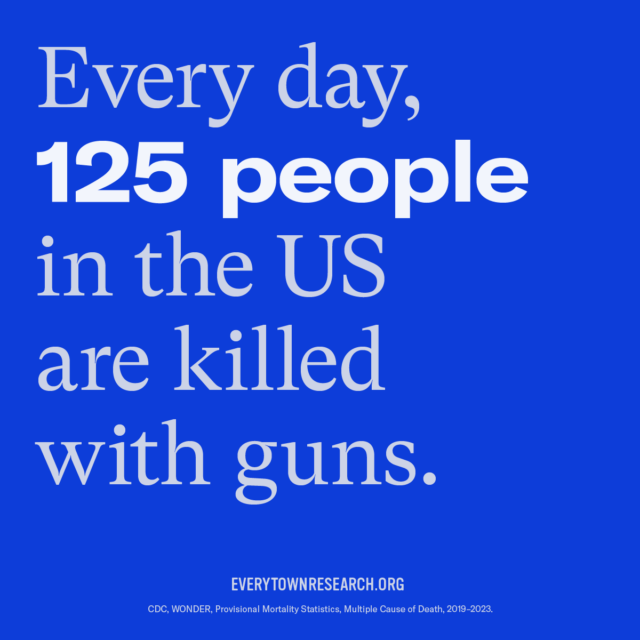
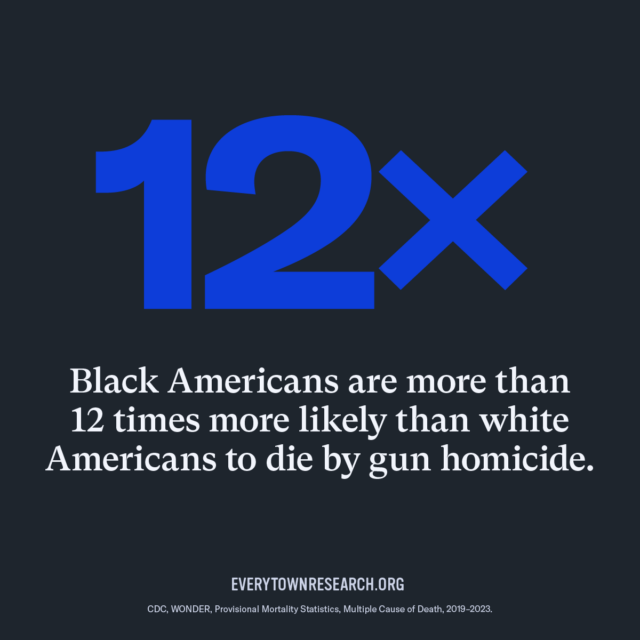
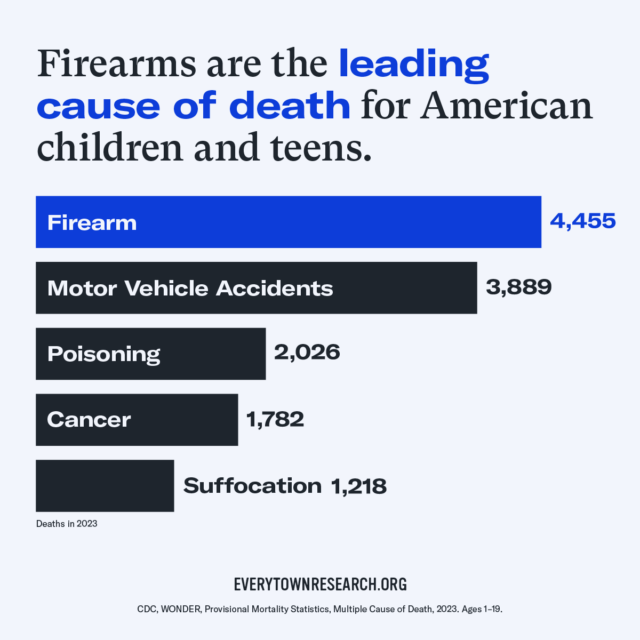
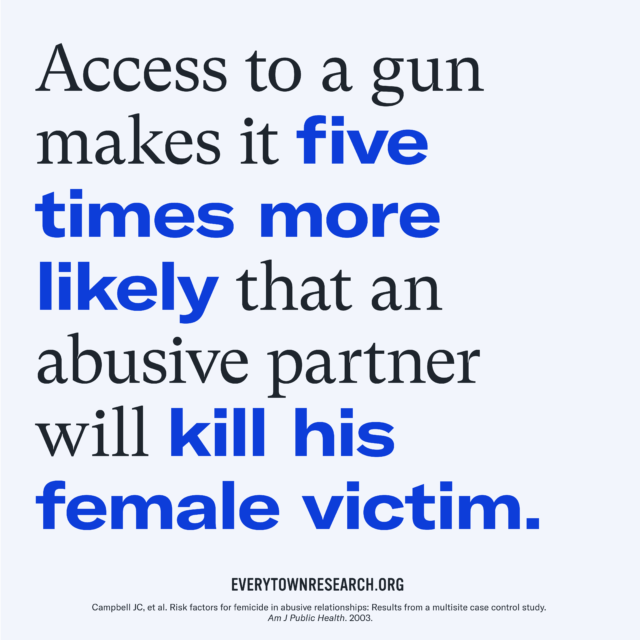

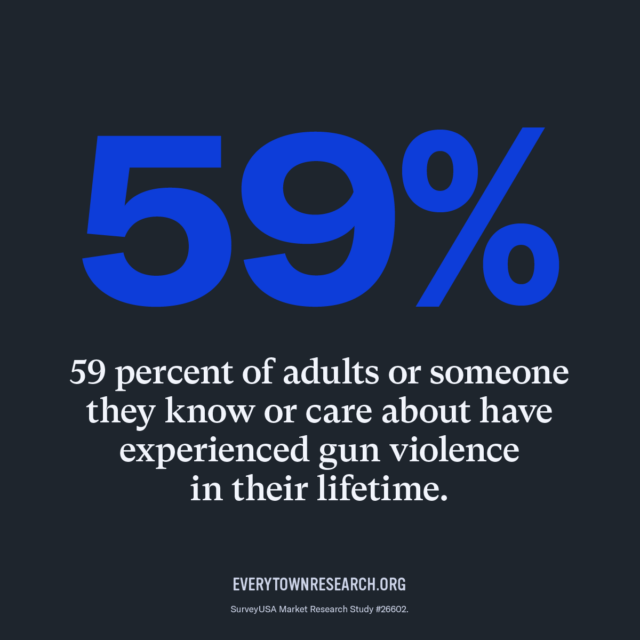
Learn More:
Everytown Research & Policy is a program of Everytown for Gun Safety Support Fund, an independent, non-partisan organization dedicated to understanding and reducing gun violence. Everytown Research & Policy works to do so by conducting methodologically rigorous research, supporting evidence-based policies, and communicating this knowledge to the American public.


